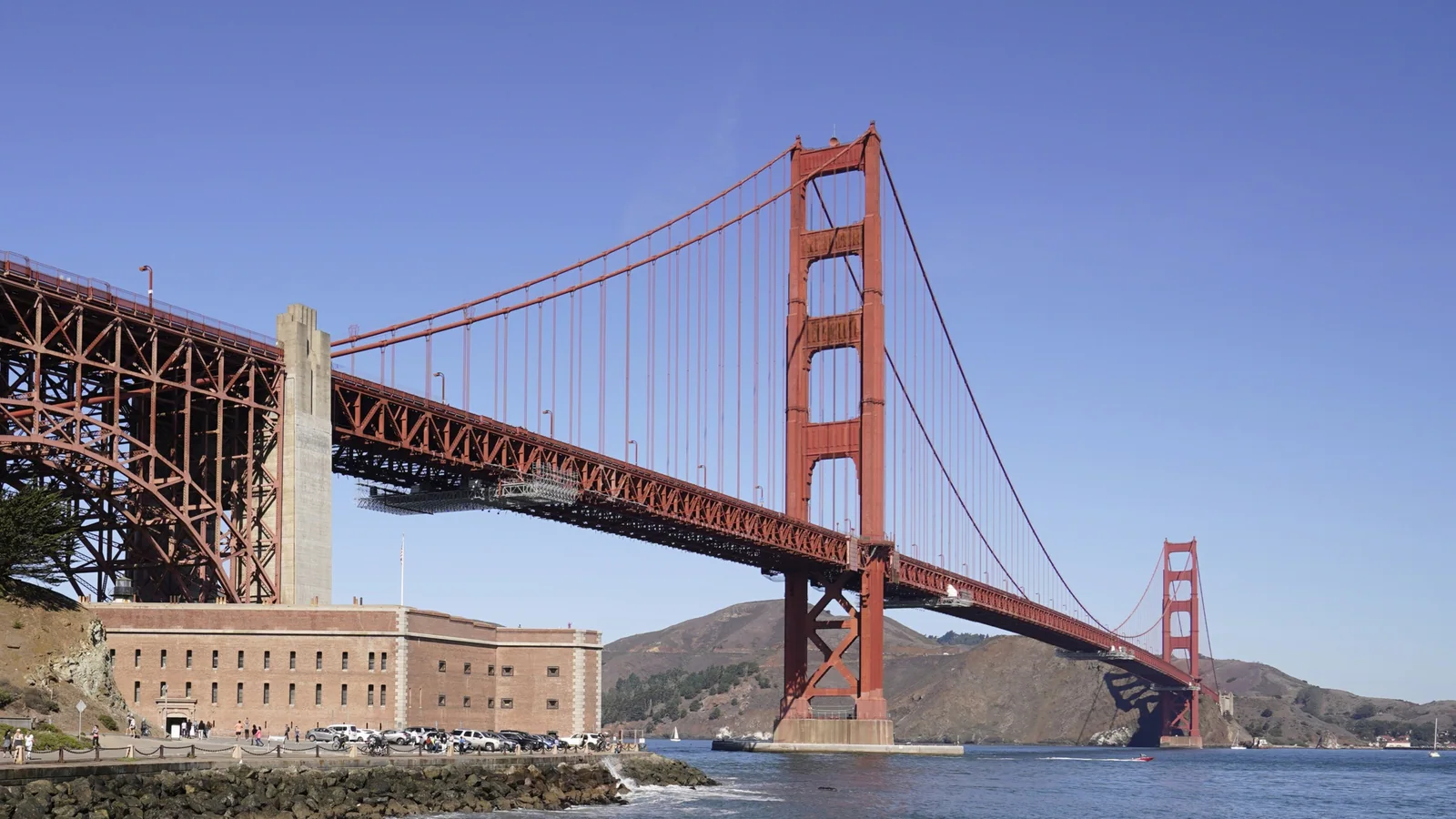Indian American Boy Golden Gate Bridge - The Inspirational Story Behind
The Indian American boy Golden Gate Bridge hold a special connection that intertwines their stories. As a prominent landmark in San Francisco, the Golden Gate Bridge has captured the hearts of millions with its iconic beauty and engineering marvel.
Jane RestureJul 05, 2023356 Shares59305 Views

The Indian American boy Golden Gate Bridgehold a special connection that intertwines their stories. As a prominent landmark in San Francisco, the Golden Gate Bridge has captured the hearts of millions with its iconic beauty and engineering marvel.
Meanwhile, the Indian-American boy represents the vibrant cultural diversity and rich heritage of the Indian-American community. Together, their encounter and shared experience create a unique narrative that showcases the intersection of culture, identity, and the power of human connection.
In this article, we will delve into the story of the Indian-American boy and the Golden Gate Bridge, highlighting their significance and the impact they have on individuals and communities alike.
What Is Golden Gate Bridge?
A massive suspension bridge, the Golden Gate Bridge spans the Golden Gate Strait in California, United States. It is a link between the two major cities of the San Francisco Bay Area, San Francisco and Marin County. Its main span is at 4200 feet (1280 meters), making it one of the longest bridges in the United States.
On May 27th, 1937, at a cost of about $27 million, the bridge was opened to the public. Its construction lasted more than four years, yet it was finished on time and within budget. Every day, more than two hundred ships pass under the bridge, making it a vital commercial and recreational waterway.
The price of crossing the bridge varies with the distance covered. Vehicle tolls were $5 outside of rush hour and $6.35 within those times in 2008.
Here are the most frequently asked questions regarding the Golden Gate bridge's history before we get into the details.
In the 1906 San Francisco earthquake, the Golden Gate Bridge was destroyed. After further investigation, experts determined that strong winds were to blame for the collapse of the bridge.
Engineers built a new bridge next to the old one with tougher (and hence less flexible) suspension cables, more separation between the cables and the highway, additional towers on the shoreline on both sides of the bridge that also functioned as anchors for lengthy diagonal cable bracing, and lightning rods.
To many, the Golden Gate Bridge represents everything that is great about San Francisco. In 1919, plans were drawn up for the bridge, and by 1937, the first span had been completed across the Golden Gate Strait. The bridge was first started in 1933 and completed in 1935.

History of Golden Gate Bridge
Incident Of Indian American Boy Golden Gate Bridge
According to his parents and US Coast Guard authorities, an Indian American teenager is suspected to have leaped from San Francisco's famed Golden Gate Bridge and perished.
The bicycle, phone, and backpack of the 16-year-old youngster were discovered on the bridge. They suspect the twelfth student leapt from the bridge at roughly 4.58 p.m.
Coastal guards claimed they promptly launched a two-hour search and rescue effort after seeing "a human" drop from the bridge.
They claim there is little reason to suppose the youngster is still alive.
According to community leader Ajay Jain Bhutoria, this is the fourth instance with an Indian American attempting suicide by leaping from the Golden Bridge.
According to the Bridge Rail Foundation, a non-profit organization dedicated to eliminating suicides on the Golden Gate Bridge, 25 individuals committed themselves on the bridge last year, and approximately 2,000 suicides have been documented since the bridge's opening in 1937.
On both ends of the 1.7-mile bridge, the state government is trying to install a 20-foot-wide iron mesh. However, the project, which was supposed to be finished by January of this year, is falling behind schedule, and the building cost has risen from 137.26 million Euro to roughly 386.64 million Euro. The work on this project began in 2018.
Suicide Barrier On Golden Gate Bridge
In 2022, a tragic number of 22 individuals took their own lives on the San Francisco Golden Gate Bridge. Recognizing the urgent need to prevent further incidents, the Golden Gate Bridge, Highway and Transportation District (GTD) took decisive action.
Back in 2018, they allocated a substantial amount of 400 million dollars to finance the installation of a suicide barrier on the iconic bridge. With a target completion date set for the end of 2023, this initiative holds the promise of permanently eradicating the bridge's reputation as a destination for suicides.
The suicide barrier, made of steel, is being installed on both sides of the historic landmark and will extend 20 feet outward from the bridge. While the barrier is not yet fully in place, the Golden Gate Bridge Patrol, in collaboration with the California Highway Patrol, continues to monitor any attempts on the bridge.
Paolo Cosulich-Schwartz, the Director of Public Affairs at GTD, shared some encouraging news. In 2022 alone, outreach teams successfully intervened in 160 attempted suicides.
These interventions often require the assistance of other organizations such as the California Highway Patrol and the San Francisco Fire Department. Cosulich-Schwartz expressed his gratitude and acknowledged the dedication of the staff, bridge patrol, ironworkers, and the California Highway Patrol in carrying out this essential work.
Although the California Highway Patrol primarily monitors activities on the Golden Gate Bridge, GTD trains Bridge Patrol Officers to intervene during suicide attempts.
These officers undergo crisis intervention training, equipping them with the skills to engage individuals in distress and guide them away from the edge. Mental health resources are also provided to support Bridge Patrol Officers in coping with the emotional toll of their challenging roles.
Kevin Briggs, a former CHP officer and an expert in suicide intervention, played a pivotal role in saving over 200 people from jumping off the Golden Gate Bridge during his 23-year career.
Briggs emphasized the significance of remaining calm and establishing a genuine connection with individuals in distress. By engaging in compassionate conversations, he aimed to provide an outlet for people to express their struggles and find solace.
Beyond mental health concerns, Briggs shed light on the existence of myths surrounding the Golden Gate Bridge that may contribute to the high number of suicide attempts.
These myths romanticize the act, portraying the bridge as a gateway to another dimension or a means of escaping troubles and finding purification in the waters below. In his experiences, Briggs explained the grim reality of the physical impact and the tragic consequences that follow a jump from the bridge, debunking these myths.
Briggs, like many others involved in suicide prevention, carries the weight of traumatic memories from witnessing individuals take their own lives. After retiring, he sought professional help from a licensed psychiatrist, recognizing the value of speaking openly about these experiences to aid in his own recovery.
The installation of the suicide barrier on the Golden Gate Bridge, coupled with ongoing vigilance and support from dedicated personnel, represents a significant step towards preventing further tragedies.
The collective efforts of the Golden Gate Bridge, Highway and Transportation District, law enforcement agencies, outreach teams, and mental health professionals aim to save lives and provide a glimmer of hope to individuals in crisis.
Golden Gate Bridge Fact Sheet
- From abutment to abutment, the Bridge is 1.7 miles long (8,981 feet; 2,737 meters).
- From abutment to abutment and including the distance to the Toll Plaza, the total length of the Bridge is 9,150 feet (2,788 meters).
- The total length of the suspension bridge, from end to end, is 1.2 miles (6,450 feet or 1,966 meters).
- The primary span of the suspended structure (the horizontal distance between the towers) is 1,280 meters (4,200 feet).
- The length of a single side span is 3,43 yards (1,125 feet).
- The bridge's width is 27 meters or 90 feet.
- The distance between the sidewalks is 62 feet (19 meters).
- The walkway is three meters wide, or 10 feet.
- A height of 220 feet (67 meters) above means higher high water is sufficient.
- There are 60,000 tons (54,400,000 kg) of anchoring in each one.
- Bridge, anchorages, and approaches weighed a total of 894,500 tons (811,500,000 kg) when they were first built.
- There are a total of 894,500 tons (811,500,000 lb) in the Bridge, anchorages, and approaches from 1937.
- The combined mass of the Bridge, its anchorages, and its approaches is 804.7 million kg (1986*).
- The total weight of the bridge is 419,800 tons (380,800,000 kg *) in 1986, and that's just the suspended structure, major towers, piers and fenders, bottom lateral system, and orthotropic redecking.
- The weight savings attributable to the 1986 redecking project are reflected in the overall bridge weight given for that year. The total mass of the first deck's reinforced concrete and stringers was 166,397 tons (150,952,000 kg).
- With the addition of the two inches of epoxy asphalt topping and the pedestals, the total weight of the newly installed orthotropic steel plate deck is now 154,093 tons (139,790,700 kg). There was a total weight savings of 12,300 tons (11,158,400 kilograms), which equates to 1.37 tons (1,133 kilograms) per lineal foot of deck.
People Also Ask
Where Can I Find More Information About The Indian-American Boy And The Golden Gate Bridge?
You can find more information about the Indian-American boy and the Golden Gate Bridge through various online sources such as news articles, blogs, and websites that cover human interest stories or bridge-related events.
What Is The Significance Of The Indian-American Boy's Encounter With The Golden Gate Bridge?
The encounter between the Indian-American boy and the Golden Gate Bridge holds significance as it represents the bridging of cultures and the power of human connection. It highlights the harmonious blending of diverse backgrounds and serves as a symbol of unity and understanding.
Are There Any Books Or Films That Tell The Story Of The Indian-American Boy And The Golden Gate Bridge?
While there may not be specific books or films dedicated solely to the story of the Indian-American boy and the Golden Gate Bridge, there are various literature and film works that explore the themes of cultural diversity, human connections, and the significance of iconic landmarks like the Golden Gate Bridge.
Has The Indian-American Boy's Encounter With The Golden Gate Bridge Inspired Any Artistic Or Creative Works?
The Indian-American boy's encounter with the Golden Gate Bridge may have inspired artistic and creative works such as paintings, photographs, poems, or songs that capture the essence of their meeting and the symbolic significance of the bridge.
Can You Share Any Personal Anecdotes Or Experiences Related To The Indian-American Boy And The Golden Gate Bridge?
As an AI language model, I don't have personal anecdotes or experiences. However, the story of the Indian-American boy and the Golden Gate Bridge has resonated with many people, and there may be individuals who have shared their personal experiences or reflections on this encounter through social media platforms, blogs, or personal narratives.
Final Thoughts
The story of the Indian-American boy and the Golden Gate Bridge exemplifies the beauty of diversity and the power of human connection. It symbolizes the harmonious blending of cultures and the bridge between different worlds.
The encounter between the Indian-American boy and the iconic bridge serves as a reminder of the shared experiences that unite us all, transcending boundaries of nationality, ethnicity, and background.
It showcases the transformative effect that meaningful encounters can have on individuals and communities, fostering understanding, appreciation and a sense of belonging.
The Indian-American boy and the Golden Gate Bridge stand as beacons of inspiration, reminding us of the limitless possibilities that emerge when cultures come together in harmony.
Latest Articles
Popular Articles